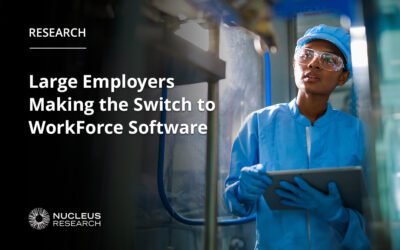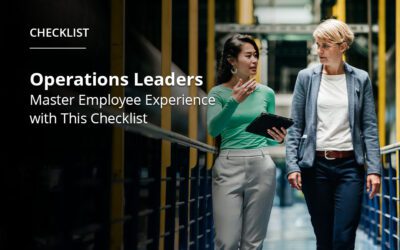Some Employee Experience Perspectives of Employers Still Fall Short


Steve Goldberg
HCM Industry Analyst, Advisor, Influencer
In her #1 NY Times bestseller of 2018, “Dare to Lead,” hugely popular researcher and storyteller Brené Brown empirically explored how demonstrating what employees mean to your organization and consistently showing them appreciation leads to a culture of belonging, one where employees also feel valued.
The notion of “feeling valued” is arguably one of the main ways employee experience initiatives, and related actions, values, and approaches, should parallel (or should be analogous to) customer experience efforts. When customers feel that a business recognizes their interests, goals, and preferences, as well as day-to-day challenges, and that these considerations are reflected in their interactions, it usually results in a return customer. Many customers will take that even further and become loyal to the point of being an ambassador that recommends that business to others, regularly extolling the virtues of the brand.
Applying the Logic of Poor Customer Experience to Employee Experience
For a hypothetical, let’s say that a subset of a business’ customers, for whatever set of reasons, have not been effectively reached with efforts known to reliably deliver great outcomes. Whether a function of poor planning, sub-optimal policies, or core values, the customer cohort placed in this unenviable position simply cannot be counted on for their occasional business and the associated financial benefits, let alone to consistently show brand loyalty. Given this, what could be the rationale for the presence of these distinctly different approaches toward customer groups?
It’s logical to assume several factors are actually at play, and that barring malevolent motives or biases, these likely encompass a combination of ineffective or poorly trained managers or team leaders, ill-designed processes (including those involving data capture in support of personalization efforts for example), and/or technology that just wasn’t purpose-built. These factors influence all aspects of the user experience, underlying architecture, automation and collaboration rules, workflow design and communication standards, reporting and analytics, and more.
How Poor Employee Experience Impacts Business Outcomes
If we consider an employee experience scenario with parallel dynamics where a similar-quality experience is not enjoyed by all employees, then a business should anticipate less than desirable outcomes. In specific terms, this means that a certain contingent of employees will be less engaged and therefore less productive, with the latter being arguably the most critical metric when reviewing the impact employees have on a business. Moreover, this group of dissatisfied workers will typically not take a long-term view of their relationship with the organization, which often has a “negative multiplier effect” in terms of how other work colleagues are affected.
Now let’s consider the experience or plight of most deskless workers out in the field directly servicing customers—and let’s also think about how their employers view them strategically. No doubt a percentage of employers are very attuned to the fact that efforts must be made to have these workers truly feel connected to the business, one of the by-products of a high-quality employee experience. This requires a commitment that is both continuous and highly tangible. Feeling meaningfully connected to an organization and a bigger mission correlates with feeling valued and believing that an employer cares about one’s needs, interests, and goals, even when they are somewhat unique or not highly linear or predictable. Unfortunately, for a fair percentage of employers and leadership teams, the ‘continuous and highly tangible’ commitment to having this segment of the workforce feel connected and valued is just not evident, even when these workers are in the majority. So, what is lacking?
Well for one thing, just as in the sub-optimal customer experience discussion, more than likely the systems and technology tools used to manage deskless, field-based workers in these organizations were not purpose-built to reflect the unique realities of their day-to-day operating context. One manifestation of this is often inadequate attention given to ensuring system and technology interactions and usage occur in the flow of work. Whether these interactions are the all-important manager/employee check-ins, the employee completing administrative tasks such as swapping a shift with a colleague, pursuing learning opportunities, or just knowing their PTO balance, it cannot be emphasized enough that when a “flow of work” design model is utilized, the quality of a deskless worker’s employee experience should be noticeably higher, and all resulting business benefits to the organization should be more compelling.
Offering a Superior Employee Experience
Modern enterprises are becoming acutely aware of the parallels between a superb customer experience and superior employee experience. While this assertion applies to many organizations employing deskless and field-based workers, there are still those who are late in coming to the realization that many of their counterparts now view as an absolute business imperative. It starts with the recognition that ALL employees have an intrinsic need to do meaningful work, feel valued, and be productive; that ALL workers want a line of sight into their career growth trajectory and how it is supported by their employer; that ALL employees should perceive fairness in how they’re evaluated, rewarded and invested in; and finally, that the ENTIRE workforce has tools at their easy disposal that enhance their engagement and productivity.
Build your case for better employee experience with our Workforce Experience Activation Guide.
The Author:
Steve Goldberg’s 30+ year career on all sides of HR process & technology includes HR exec roles on 3 continents, serving as HCM product strategy leader and spokesperson at PeopleSoft, and co-founding boutique Recruiting Tech and Change Management firms. Steve’s uniquely diverse perspectives have been leveraged by both HCM solution vendors and corporate HR teams, and in practice leader roles at Bersin and Ventana Research. He holds an MBA in HR, is widely published and is a feature speaker around the globe. He’s been recognized as a Top 100 HRTech Influencer.
Subscribe to The WorkForce Blog
Learn the art and science of maintaining productive, happy, engaged employees.
Discover More
Nucleus Insights from WorkForce Customers Research Note
Nucleus Research interviews WorkForce customers who validate why we’re ranked the #1 WFM enterprise vendor for 10 consecutive years.
Elevate Employee Experience: Checklist for Operational Leaders
Get the practical steps and technology functionalities operation leaders need to improve their employees’ work experiences.
Streamlining Complex Workforce Compliance Requirements Boosts Productivity
Discover how workforce compliance software helps EMEA organisations navigate complex legislation, enhance compliance and boost operational efficiency.



